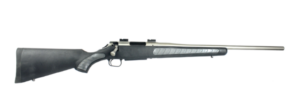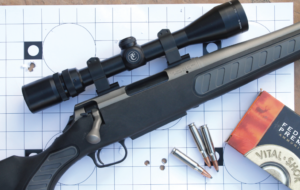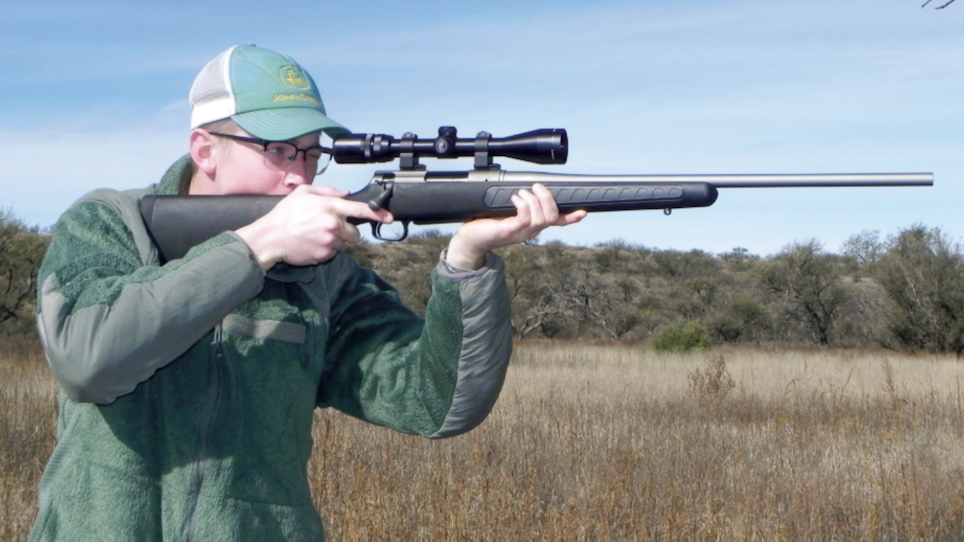T/C's Venture Weather Shield rifle traces its lineage to the T/C Icon rifle. It retains many of the Icon's features, but at a much lower price. Photo: Scott Mayer
Back in 2009 when Thompson/Center first introduced the Venture rifle, its intent was to get a lightweight T/C rifle with desirable features in the hands of hunters for less money than the company’s then-flagship, Icon rifle.
It was good timing, because depending on whom you ask, 2009 was also either the beginning, middle or the end of the Great Recession. Money was tight. Americans were hit hard financially; yet, the political atmosphere was causing an increase in Modern Sporting Rifle sales. Thompson/Center’s decision to introduce an affordable bolt-action rifle to initiate brand loyalty made perfect sense.
Since then, wallets have gotten fatter, but consumers and the industry have shown a definite affinity for what fellow gun writer, Steve Comus, coined “Modern Bolt-Action” rifles — firearms efficiently engineered for budget-conscious consumers without sacrificing accuracy or quality. Characteristics of MBAs are manufacturing efficiencies such as full diameter bolt bodies, three locking lugs for a 60-degree bolt lift and synthetic stocks with molded-in trigger guards. From there, the respective makers tend to distinguish their guns from each other in this genre with such features as differing bedding systems, recoil lug styles, special finishes, zero-headspace assemblies or various trigger types.
Within the MBA genre, there are also two tiers: Entry level, which are your basic rifles; and mid-level, which typically are more refined and have more advanced features. The Venture is an example of the mid-level tier, and there are several versions including Weather Shield, Predator and Compact available.
“T/C engineers develop[ed] the Venture, which has great features people love, from the Icon," said Matt Spafford, T/C's Media Manager, Firearms. "The bolt is pretty close to the same, the magazine is similar, as well as the safety, but we introduced a composite stock and made it a much lighter weight and a much more mid-level price point.”

Thompson-Center Venture Predator (Photo Thompson-Center Arms)
Harsh Conditions? Bah!
Of interest to whitetail hunters is the Venture Weather Shield version.
“Think rain, snow, mud — all of that is what Weather Shield is designed to protect against,” Spafford says of the essence of Weather Shield. “Think Alaska, Saskatchewan, up in snow in Wyoming or Maine. Think, Southeast or the Pacific Northwest where there is a lot of high humidity and wetness during the seasons."
Weather Shield is an exterior metal coating that protects against the effects of weather.
“This system, when applied to the barrel and other critical metal parts, makes the gun nearly impervious to rust,” Spafford said. “Environmental testing proves Weather Shield is 50 times more corrosion resistant than stainless steel alone. After 350 hours of exposure to normal environmental elements, stainless steel showed rust and wear, while Weather Shield remained unaffected.”
That’s a good thing if you hunt where it’s wet, but there other features on the Venture that are less environmentally specific but have much broader appeal for hunters.
Other Venture Features
For example, the Venture uses 5R rifling Spafford calls “instrumental” for accuracy. With that type of rifling, lands are oriented opposite the grooves, making it easier for bullets to engage the rifling initially. According to Spafford, 5R “delivers superior accuracy by causing less bullet deformation, giving greater bullet stability over multiple shots.” Many users also report that because the rifling doesn’t “dig in” as harshly in the bullet jacket, that bores stay cleaner longer and are easier to clean.
Another broadly appealing feature is the trigger, which is user-adjustable from 3.5 to 5 pounds pull. Many MBAs offer adjustable triggers as well, but several of those require you to remove the barreled action from the stock to make the adjustment while the Venture does not. Instead, shooters adjust trigger pull by removing the bolt and then turning a small Allen-head screw in the raceway either clockwise to increase pull weight or counter-clockwise to decrease it. T/C even provides with right size Allen wrench. Spafford calls it a “pretty handy feature, especially if you’re out on the range with the rifle,” and he’s right, though it’s a little cramped trying to make the adjustment with a scope in place. Shooters definitely should make trigger adjustments before mounting a scope.
Another feature that is appealing to a more general hunting audience is the synthetic stock. Not only is it a lot lighter than the Icon’s wooden stock, the synthetic is not subject to warpage or change caused by varying environments. It has bedding pillars, and I noted they come up just a little short of touching the bottom of the receiver. On mass-produced rifles with pillar bedding, I’m accustomed to seeing the tops of the pillars mate precisely with the bottom of the receiver.
A bit of research showed that some noted stock-makers, such as McMillan, leave a small gap between the top of the pillar and the bottom of the receiver (McMillan’s is 0.035-inch) to “create a completely uniform bedding surface that is 100 percent consistent.” McMillan notes that, “By not allowing the aluminum pillar to come in contact with the receiver, we have eliminated one possible source for unwanted stress. While other techniques are used, we believe ours creates the perfect relationship between the stock and action.” On the Venture, the recoil lug and action bottom mate skin-tight with the stock, effectively creating a conventional bedding system.
“They’re comfortable to shoot,” Spafford notes of the stock’s ergonomics. “[B]oth the pistol grip and forend come with the Hogue overmolded grip inserts, which are a really nice feature on that stock, it’s a really comfortable stock."
To further aid in shooter comfort, Venture rifle stocks come with what T/C calls “Energy Burners.” These are rubber coils, or arcs, that when placed at precise locations in the stock achieve the maximum amount of shock absorption possible. This makes recoil feel a little softer on the shoulder.

The Venture Weather Shield was able to shoot three-shot groups that were less than 1 MOA at 100 yards. The best groups: 0.93-inch with the Federal, 0.96-inch with the Hornady and exactly 1.00-inch with the Winchester. (Photo: Scott Mayer)
Venture on the Range
I spent range time with T/C’s Venture Predator model and was impressed with its accuracy, so I looked forward to seeing if the Weather Shield chambered in .308 Winchester performed comparably. Because of such things as the 5R rifling, bedding and adjustable trigger, T/C is confident enough in the Venture to offer a 1-MOA accuracy guarantee of three shots at 100 yards, using premium ammunition.
The Weather Shield comes with Weaver-style scope bases already mounted, so I topped it with one of T/C’s Hawken Hunter 3-9x40mm scopes — sold separately on T/C’s website — and gathered up a few boxes each of Federal Premium 165-grain Sierra GameKing boattail soft-point and Hornady’s Whitetail 150-grain InterLock. I also brought along a partial box of Winchester’s Super-X 150-grain Power-Point.
With all the loads, the Venture Weather Shield was able to shoot three-shot groups that were less than 1 MOA at 100 yards. The best groups: 0.93-inch with the Federal, 0.96-inch with the Hornady and exactly 1.00-inch with the Winchester. That said, the averages of five three-shot groups for the Federal and Hornady loads were 1.18 and 1.22, respectively. There weren’t enough cartridges in the partial box of Winchester to shoot enough groups to provide a meaningful average.
Sub-MOA accuracy was also my experience when I had the Venture Predator rifle on the range, and you can see that consistency reflected in the comments of other Venture owners. “Tbone-AZ” posts in a popular shooting forum that his Venture “shoots way better than I could hope for,” while “Dotson” writes that his Venture, “[p]laced the first three in 1 1/4 inches, the next three at 7/8, and the next at 5/8 of an inch.
As it came from the factory, the trigger pull was 4.1 pounds, which is where I left it. There is no take-up before the crisp break, but there is a little more than 1/8 inch of overtravel, so you’ll want to make sure to use good follow-through when shooting.
In my experience, cartridges such as the .308 Win. are about the upper level of recoil for the average hunter. It may be the Energy Burners or simply the ergonomics of the straight stock, but the Venture was a comfortable rifle to shoot. I’d even go so far as to say that if you can handle a .308 Win. in other rifles, you can probably shoulder .300 Win. Mag. in this one.
I didn’t have any malfunctions. The gun shot great. The only possible quibble I could have with the Venture Weather Shield is you can’t top off the three-shot synthetic magazine while it’s in the gun. You can, single load, however.
“The T/C Venture comes with a limited lifetime warranty against manufacturers defects as well as the MOA guarantee," Spafford said, "so those two features are really great for ensuring you have a rifle that is going to work and that its going to be very accurate.”
As manufacturers continue to engineer designs that let them make rifles less expensive, features such as T/C’s accuracy and warranty provide the kind of comfort a hunter needs in the field. It’s good to know that just because a rifle is affordable, doesn’t mean it’s cheap.
SPECS: T/C Venture
MANUFACTURER: T/C Firearms
MODEL: Venture Weather Shield
CALIBERS: .22-250 Rem., 6.5 Creedmoor, .270 Win., 7mm-08, 7mm Rem. Mag., .308 Win., .30-’06 Sprg., .300 Win. Mag.
ACTION: Bolt-action repeating
MAGAZINE: Detachable, 3+1 capacity
BARREL: Free-floating, 5R rifling, 22-24 inches
TRIGGER: Single-stage, externally adjustable 3.5-5 pounds pull
SIGHTS: None. Weaver-style bases installed
STOCK: Black synthetic
OVERALL LENGTH: 39 3/4 - 43 1/2 inches
WEIGHT: 7 pounds
OTHER: Weaver-style scope bases installed
MSRP: $578
FOR MORE INFORMATION: www.tcarms.com




